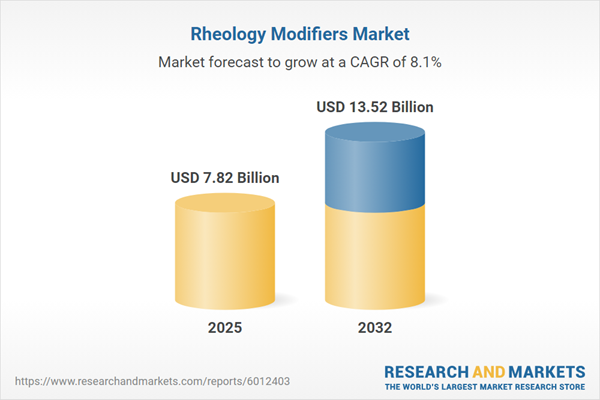Speak directly to the analyst to clarify any post sales queries you may have.
The rheology modifiers market is rapidly evolving as industry players leverage new technologies, adapt to regulatory shifts, and pursue advanced innovation strategies. Senior executives navigating this environment can achieve organizational resilience and future growth through agile operational and procurement decisions.
Rheology Modifiers Market Snapshot
Rheology modifiers have become critical to the operational success of multiple sectors, with the global market valued at USD 7.24 billion in 2024 and a projected compound annual growth rate of 8.11%. Estimates position market value at USD 7.82 billion in 2025 and USD 13.52 billion by 2032. Growth is driven by enduring demand from construction, personal care, and pharmaceutical industries. Companies are directing capital toward digital R&D platforms and innovative formulation technologies, resulting in measurable gains in compliance, productivity, and responsiveness to fast-changing customer requirements.
Scope & Segmentation in the Rheology Modifiers Market
- Material Types: Cellulose ethers, inorganic compounds, natural polymers, and synthetic materials are strategically deployed to elevate efficiency, sustainability, and quality across broad industry applications.
- Functions: Emulsion stabilization, viscosity control, flow regulation, and thickening ensure consistent process performance and product stability while supporting compliance in regulated uses.
- Applications: Adhesives, sealants, paints, coatings, and drilling fluids take advantage of tailored rheology solutions. Specialized uses include cosmetics, hair care, and select healthcare products, focusing on quality and functional performance.
- End Use Industries: Construction, energy, mining, manufacturing, personal care, and pharmaceuticals depend on rheology modifiers to maintain product integrity and navigate demanding regulatory landscapes.
- Distribution Channels: Direct sales, specialty distributors, and digital commerce allow for adaptable go-to-market approaches. Flexible supply models give organizations the agility to reach target customers efficiently.
- Regions: The Americas, Europe, Middle East and Africa, and Asia-Pacific all feature distinct regulatory requirements and competitive structures, requiring region-specific commercial and compliance strategies.
- Key Companies: BASF SE, Dow Inc., Ashland Global Holdings Inc., Evonik Industries AG, Wacker Chemie AG, Croda International Plc, Eastman Chemical Company, Clariant AG, Arkema S.A., and Solvay S.A. utilize advanced technology and diverse product portfolios to address evolving client needs.
Key Takeaways for Senior Decision-Makers
- Hybrid and bio-based chemistries are gaining momentum, supporting sustainable product lines while fulfilling compliance mandates within regulated sectors.
- Digital transformation using machine learning and automation has become essential for optimized research and quicker product development cycles.
- Portfolio expansion provides organizations with the flexibility to address emerging trends, new formulations, and unforeseen changes in customer requirements.
- Procurement strategies increasingly emphasize robust supply chain partnerships and risk management to ensure business continuity in volatile trading environments.
- Collaboration through regional alliances enables focused adaptation to local market regulations and enhances compliance with evolving standards.
Tariff Impact on Procurement Strategies
Recent changes in United States tariff policy have prompted organizations to restructure procurement and supply chains. The market response focuses on nearshoring, adopting domestic sourcing models, and strengthening supplier relationships. Enhanced contract management practices and targeted contingency planning now mitigate disruptions, maintain cost control, and help preserve operational resilience during policy shifts.
Market Research Methodology & Data Sources
Research methodologies draw upon the expertise of professionals in formulation science, procurement, and compliance. Using literature and patent analysis, advanced modeling, and scenario planning, the study delivers actionable and reliable projections aligned with industry realities.
Why This Rheology Modifiers Report Matters
- Executive teams gain clear, practical direction for navigating regulatory and technological changes that shape procurement and operational decisions.
- Competitive benchmarks and established practices allow organizations to adapt quickly and foster innovation amidst shifting market needs.
- Informed analysis of digitalization trends and trade policy shifts empowers leaders to refine strategies and secure supply chain continuity.
Conclusion
A future-focused approach—anchored in data and actionable insights—enables decision-makers to strengthen compliance, drive sustainable innovation, and maintain growth in a changing rheology modifiers market.
Additional Product Information:
- Purchase of this report includes 1 year online access with quarterly updates.
- This report can be updated on request. Please contact our Customer Experience team using the Ask a Question widget on our website.
Table of Contents
3. Executive Summary
4. Market Overview
7. Cumulative Impact of Artificial Intelligence 2025
Companies Mentioned
The companies profiled in this Rheology Modifiers market report include:- BASF SE
- Dow Inc.
- Ashland Global Holdings Inc.
- Evonik Industries AG
- Wacker Chemie AG
- Croda International PLC
- Eastman Chemical Company
- Clariant AG
- Arkema S.A.
- Solvay S.A.
Table Information
| Report Attribute | Details |
|---|---|
| No. of Pages | 185 |
| Published | November 2025 |
| Forecast Period | 2025 - 2032 |
| Estimated Market Value ( USD | $ 7.82 Billion |
| Forecasted Market Value ( USD | $ 13.52 Billion |
| Compound Annual Growth Rate | 8.1% |
| Regions Covered | Global |
| No. of Companies Mentioned | 11 |









